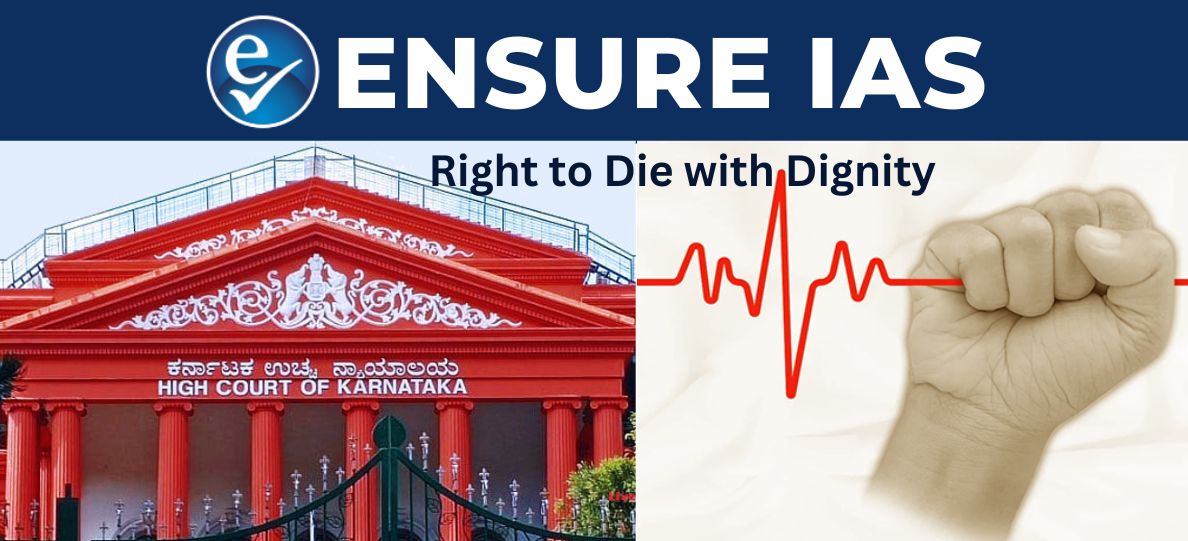- Courses
- GS Full Course 1 Year
- GS Full Course 2 Year
- GS Full Course 3 Year
- GS Full Course Till Selection
- Answer Alpha: Mains 2025 Mentorship
- MEP (Mains Enrichment Programme) Data, Facts
- Essay Target – 150+ Marks
- Online Program
- GS Recorded Course
- Polity
- Geography
- Economy
- Ancient, Medieval and Art & Culture AMAC
- Modern India, Post Independence & World History
- Environment
- Governance
- Science & Technology
- International Relations and Internal Security
- Disaster Management
- Ethics
- NCERT Current Affairs
- Indian Society and Social Issue
- NCERT- Science and Technology
- NCERT - Geography
- NCERT - Ancient History
- NCERT- World History
- NCERT Modern History
- CSAT
- 5 LAYERED ARJUNA Mentorship
- Public Administration Optional
- ABOUT US
- OUR TOPPERS
- TEST SERIES
- FREE STUDY MATERIAL
- VIDEOS
- CONTACT US
Karnataka's 'Historic' Order on 'Right to Die with Dignity'
Karnataka's 'Historic' Order on 'Right to Die with Dignity'
07-02-2025

- On January 30, 2025, Karnataka took an important step to allow the right to die with dignity for terminally ill patients.
- The state government issued a new order to create medical boards in hospitals, making it easier for patients to request a dignified death.
- Karnataka’s new policy follows the Supreme Court's 2023 ruling, which made the rules for passive euthanasia clearer and said the right to life guaranteed under Article 21 of the Constitution includes the right to die with dignity.
- With this order, Karnataka became the 2nd State after Kerala to implement the directive.
What is Passive euthanasia?Passive euthanasia is when life-sustaining treatment is withheld or withdrawn from a terminally ill person, allowing them to die naturally from their underlying condition.
Legal status of passive euthanasia in India:
|
What is a Living Will?
- A living will is a legal document made by people aged 18 or above.
- Another name for this is an Advance Medical Directive (AMD), where the patient writes down their healthcare wishes for the future.
- It allows them to decide what medical treatment they want if they become terminally ill, unable to make decisions, or suffer from a condition with no hope of recovery.
- It gives individuals to control over their healthcare, allowing them to refuse life-support treatment if they no longer want to continue living in a suffering state.
Karnataka’s Historical Order on Living Wills :
1. Establishment of Medical Boards:
- The Karnataka government ordered the creation of primary and secondary medical boards in hospitals.
- These boards will decide on requests to withdraw life-sustaining treatment (WLST) for patients who are terminally ill or in a persistent vegetative state.
- The goal is to allow terminally ill patients to die with dignity, based on their living wills or their family's request.
2. Role of Medical Experts:
- The District Health Officers will appoint medical experts to form these boards, which will examine the patient's case and decide if life-support treatment should be withdrawn.
- Each board will consist of three registered medical practitioners.
3, Approval Process:
- First, the treating doctor must approve the patient’s living will and the family’s request for WLST.
- The request will then be reviewed by both the Primary and Secondary Medical Boards.
- Once the boards agree, their decision will be sent to the Judicial Magistrate of the First Class (JMFC) for review. After approval, the decision will be recorded with the High Court.
4. Role of the Patient:
- The patient must choose at least two people to make healthcare decisions for them if they lose the ability to do so themselves.
- The living will (AMD) can be submitted as a physical or digital document and will be kept in the patient's medical records.
Other States’ Initiatives:
- In June 2024, Goa became the first state to register a living will. Justice of the Goa Bench of the Bombay High Court, registered his own living will.
- In September 2024, the Union Health Ministry announced draft guidelines on passive euthanasia, inviting public feedback. The guidelines suggest conditions to decide when passive euthanasia should be allowed.
Concerns from Medical Bodies:
- The Indian Medical Association (IMA) has raised concerns about the potential legal issues doctors might face when following these new guidelines on passive euthanasia.
About Indian Medical Association (IMA):
|

|
Also Read |
|




